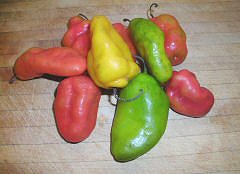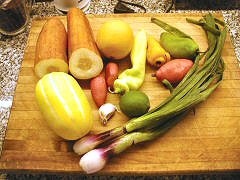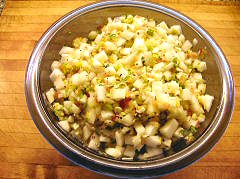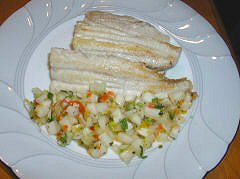 Buenos Aires – First I have to introduce the last important ingredient in the salsa I’ve been nattering on about for a week, the rocoto (also known as locoto in Bolivia). While certainly not the only hot pepper of Peru, it is probably one of the most important, especially when it comes to fresh peppers. The rocoto is not blazingly hot – it has a nice fiery burn, but not so much so that you can’t take a bite out of one – in fact, that seems to be quite common – serving one as a sort of side dish – Henry will often munch on one on the side of his dinner, and I’ve learned to do the same. The rocoto also has a nice fruitiness to it that helps balance the fire.
Buenos Aires – First I have to introduce the last important ingredient in the salsa I’ve been nattering on about for a week, the rocoto (also known as locoto in Bolivia). While certainly not the only hot pepper of Peru, it is probably one of the most important, especially when it comes to fresh peppers. The rocoto is not blazingly hot – it has a nice fiery burn, but not so much so that you can’t take a bite out of one – in fact, that seems to be quite common – serving one as a sort of side dish – Henry will often munch on one on the side of his dinner, and I’ve learned to do the same. The rocoto also has a nice fruitiness to it that helps balance the fire.
 If you’ve been reading along, you’ve met the other two important ingredients, my bizarre orange cucumber and Korean melon (both on the left in the photo, more details by clicking on the links). The word salsa here just simply means sauce, so I’m using it more in the sense that we gringos do. When I was growing up I’m not sure that salsa existed in our world of awareness. It first came to light probably either through Taco Bell (remember when they only had one “mild” hot sauce and it actually seemed spicy?) or perhaps in a jar from El Paso foods, used to make nachos at home. Gradually it became part of the vocabulary and meant a pureed red or green hot sauce. Somewhere down the line it became ubiquitous in the American restaurant world in the form of some sort of mix of chopped fruits or vegetables, flavored with hot peppers and herbs, and served alongside some sort of meat. I’m using it in that sense.
If you’ve been reading along, you’ve met the other two important ingredients, my bizarre orange cucumber and Korean melon (both on the left in the photo, more details by clicking on the links). The word salsa here just simply means sauce, so I’m using it more in the sense that we gringos do. When I was growing up I’m not sure that salsa existed in our world of awareness. It first came to light probably either through Taco Bell (remember when they only had one “mild” hot sauce and it actually seemed spicy?) or perhaps in a jar from El Paso foods, used to make nachos at home. Gradually it became part of the vocabulary and meant a pureed red or green hot sauce. Somewhere down the line it became ubiquitous in the American restaurant world in the form of some sort of mix of chopped fruits or vegetables, flavored with hot peppers and herbs, and served alongside some sort of meat. I’m using it in that sense.
Chopped and grated and mixed it’s delicious – and the basic principle is to mix a nice balance of hot, sweet, and cooling ingredients and then just add a little basic seasoning to brighten it up. A little acidity, generally from citrus, tends to work wonders for the flavor. Something to play with! I served it all up with some very simply sauteed fish, in this case gatuzo, a local fish.


Cucumber-Melon Salsa
1 large cucumber, seeded and diced small
1 small, crisp, semi-sweet melon, seeded and diced small
2 green onions, chopped
1 large clove garlic, finely chopped
2 ají escabeche or cuzqueño, seeded and finely chopped
1 Ají Vinaigre, seeded and finely chopped
3 Rocotos, seeded and finely chopped
1 lime, finely chopped peel and juice
1 orange, finely chopped peel and juice
1 tablespoon of mixed, coarsely ground peppercorns
salt to tasteI tend to hand chop all the ingredients except the hot pepper, since it’s easier and there’s less chance of doing something silly like rubbing my eyes with a hand that has chili oil on it if I do that. I listed the different peppers I used in this particular salsa, but feel free to mix them up. The Ají Escabeche is a common pepper here and in flavor is fairly similar to something like a serrano – fairly but not overly hot. The Vinaigre is more or less what we used to call Italian Frying Peppers back home, but the main idea is something that’s more of a sweet pepper. The Rocotos I described above. The basic idea is to get a variety of different pepper flavors in the salsa, giving it more complexity of flavor. The cucumber and melon are seeded and diced small.
I normally like a mix of different citrus juices and the finely chopped or grated peel (make sure to remove the white pith on the inside of the peel, you don’t want the bitterness from that). In this case I only used a lime and an orange as the strange cucumber I was using had a very lemony flavor already – with a regular cucumber I’d add the peel and juice of a lemon as well. Mix all the ingredients together well – then season with salt and peppercorns. I used a pre-packaged mix of different peppercorns – it had white, black, green, and pink, plus “Jamaican,” which is really allspice (addeing a very unusual touch to the salsa), and coarsely ground them in a mortar (spice grinder is fine too). I like a fair amount of salt in my salsas, and probably used close to two tablespoons in this case. But add it a bit at a time, mix and taste. Normally I might add some chopped perfumey herbs, like coriander or basil, but in this case I really wanted the flavors of the vegetables to stand out on their own.
Let the mixture sit in the refrigerator for at least a few hours – I like it best after a solid day of “melding”. You can serve it cold, room temp, or slightly warmed (don’t actually cook it, just warm it up if you like). This recipe made about 2 cups of salsa, more than enough to last through multiple dishes!
Today, Too Many Chefs listed this entry as one of the three top food posts of the week! And they didn’t even get to taste the salsa!
[…] Buenos Aires – Salsa Llajwa is sometimes known as the Bolivian National Hot Sauce. I first encountered it at a restaurant in Palermo, and it was so delicious that I’d asked the manager of the restaurant what was in it. He described it as containing the Peruvian herb huacatay and the Bolivian herb quirquiña, blended with rocoto peppers and oven dried tomatoes. I’ve spent a bit of time looking for recipes, figuring one of these days, like yesterday (see last post), I’d make it out to Liniers and possibly be able to find the key ingredients. Although he didn’t mention it, every recipe I saw included either onion or garlic, so I added in a shallot. Recipes varied wildly, using various herbs, generally on the aromatic side, but from coriander to mint to parsley, and the peppers varied as well – from just rocoto to rocoto and much hotter pepper combos, to others. […]
[…] A lot of the food for last night was made in advance, no last minute sauces, things were slow cooked, so the final putting it together was fairly easy. There had to be a hot sauce, of course. I had offered to make some ají de huacatay, a green herb hot sauce, just to help him out, but he nixed that, as it’s a sauce from the Arequipa area, a long way from Trujillo, his hometown. Instead, we pureed up half a dozen red hot chili peppers, what I think are probably cayennes (at the market they were just labelled ají picante rojo), and two red rocotos, along with a large clove of garlic, a whole egg, salt, and olive oil. Nice and fiery! We put a small dish of it at each person’s place to be used if and when they desired. I think everyone tasted it, but only a couple of them really used it, mostly on the anticucho dish. […]